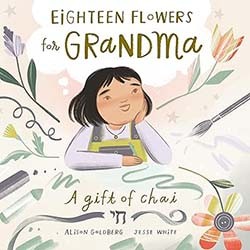While it is easy to feel nostalgic about gefilte fish, creating a children’s picture book about this traditional Jewish food is a challenge. Writer and illustrator Paula Cohen succeeds in this beautifully illustrated story about an enterprising little girl who determines to save her family’s shop by promoting this dish to non-Jewish customers. Cohen deftly avoids a preachy tone, while conveying how people of different backgrounds are both alike and different. She also sends the message to young readers that they can make a difference, even when adults are skeptical of a child’s ability to change the course of events.
Big Dreams, Small Fish is set in the 1930s or ’40s, Cohen imbues her characters and setting with the Yiddishkeit of that era. Shirley’s family has just moved to a new neighborhood, and they are aware of the need to market their specialties to customers who may never have tasted them. Delicate drawings in pastel and earth tones portray the extended clan working hard to sell their wares. Uncle Morris carefully stacks cans, while Mama tastes the soup with a look of concern on her face. Papa holds a hand lettered sign advertising gefilte fish in both English and Yiddish, one of the many authentic details in the text. A mixed-media image on the wall shows a family photograph in a frame drawn by Cohen, alluding to the history in which the book is based. Jews maintained their own customs, but also tried to assimilate into American life.
Shirley is one smart child, a real asset to her striving family. She is full of innovative ideas, which are depicted by Cohen with both humor and respect. A cooking robot and a conveyer belt to move food might all promote the store’s success, but the business confronts a real problem intrinsic to American immigrant life. While other foods are popular, no one will touch the strange fish that is a staple of Ashkenazi cuisine. Children will relate to the problem of invisibility; Shirley’s clever suggestions only make her mother “farmisht,” and lead her father to gently remind her, in Yiddish-inflected English, that “We didn’t come to this country for you to solve problems. Go play nice with the cat.”
A combination of confidence and willingness to take risks leads to Shirley’s success. But Cohen also implies that her heroine’s fondness for gefilte fish – that Jewish classic – helps her as well. Why would Miss Han, Mr. Lombardo, and Mrs. Hernandez, not become gefilte-enthusiasts, once they are persuaded to try it? Both the text and the illustrations are understated but clear: people of different races and ethnic backgrounds share more in common than they may realize. And a child standing on a stool to reach the cash register and placing a surprise in each customer’s bag is just the person to prove this point. Helping her family, proving her own worth, and reaching out to the wider world all converge in Shirley’s plan. All of those motivations are deeply-held Jewish values, unobtrusively presented in Cohen’s delightful book.
This highly recommended picture bookincludes a glossary, an explanation of gefilte fish, and a recipe from the iconic New York restaurant Russ & Daughters.
Emily Schneider writes about literature, feminism, and culture for Tablet, The Forward, The Horn Book, and other publications, and writes about children’s books on her blog. She has a Ph.D. in Romance Languages and Literatures.





